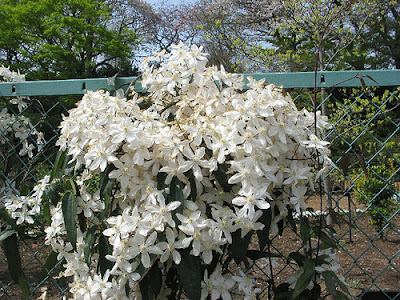The Clematis armandii, also called Armand clematis or evergreen clematis, is a magnificent species that Chinese people appreciated for its force, its large evergreen dark and shiny green and flowering early in divinely fragrant white panicles, which begins at the end of winter...
The Clematis armandii, also called Armand clematis or evergreen clematis, is a magnificent species that Chinese people appreciated for its force, its large evergreen dark and shiny green and flowering early in divinely fragrant white panicles, which begins at the end of winter.
As it does not attach itself, it is necessary to hoist it on a support like a large trellis when it is installed at the foot of a wall. This clematis is imperial planted in a hedge of shrubs on which it will be supported and which, at the same time, will hide the dead leaves that remain long attached to the branches. If it is not the most rustic, it is one of the most spectacular clematis.
Clematis armandii description:
Armandii clematis is a robust botanical species capable of rapidly covering large areas. It is native to the Himalayas, from central and western China, where it grows in deciduous and coppice forests. This species prefers soft, deep soils, and adapts lands as slightly acidic as neutral or even limestone. Its hardiness is from -12 to -15 ° C for short periods. Clematis belongs to the family of Ranunculaceae.
Clematis armandii launches from its ligneous strain 4 to 5m long quadrangular stems. Over time, this liana will occupy more than 4m wingspan. The restart of vegetation is announced in February, with the appearance of large reddish flower buds. They swell and elongate quickly to flourish in large clusters of pimples. Each gives birth to a flower 5 cm in diameter, consisting of 4 pure white tepals surrounding a heart of cream and greenish stamens. Their scent, pronounced, is reminiscent of orange blossom and almond. The flowering is over, it is the young shoots that grow on the twigs. They are spread in leaves cut into 3 large leaflets leathery, deeply ribbed, glazed, a dark green. These leaves are so firmly attached to the stems that it is difficult to separate when they dry, at the end of life. Large blackish-brown beaches are formed, more or less concealed beneath the young foliage. It may be useful to remove these dead leaves, for aesthetic reasons only.
Grow and care Clematis armandii:
Armand's clematis is a moderately hardy variety that does not withstand very cold winters, especially in heavy soil and windy conditions. It is however a star of the gardens, just like the banksiae roses with which it associates well: it resists perfectly to the dry and hot summers after 2 to 3 years of culture and attentive care, if it is well installed in deep soil, well prepared, amended and loosened. For example, install it in a hedge, the shaded foot, in which it will sneak. It can also be planted in the shade of a large tree, where it will climb to reach the light. It is best to avoid throwing it against an arbor or a pergola for two reasons: its evergreen foliage hides the sun in winter and its dry foliage, which accumulates under the vegetation, is not very aesthetic.
In sunny exposure, shade the foot of your clematis armandii with a ground cover, a low bush or a perennial geranium. Clematis like to have their feet cool and their tips in the sun. This one is rather chilly, but will be able to endure short frosts of the order of -12 to -15 ° C in healthy soil and sheltered exposure of dry and cold winds. It agrees to be planted in the dense shade of a tree or a large shrub that she climbed to bloom in the sun.
The best time for plantation is March and September. Armand's clematis prefers deep and soft soils, and supports the presence of clay and limestone. Treat the plantation: install your plant by covering the mound with 3 cm of soil, in a soil worked on 20-30 cm, lightened with a good potting soil. The first weeks, water a lot and regularly. Watch the watering the first 2 or 3 summers, in hot and dry weather: water copiously, but very spaced (once a week or once every 2 weeks depending on weather conditions).
Care: Eliminate dry leaves. Shorten each year, in May, every other stem 50 cm from the ground. Remove the dead stem. Size the stems protruding from the support. On an old clematis that has never been cut, fold one branch out of three at 2m from the ground.

















COMMENTS